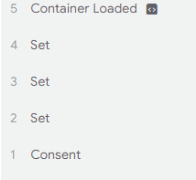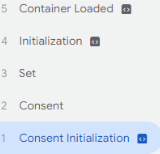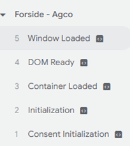Before we begin, these are the prerequisites
- Familiarity with Google Tag Manager and/or Google Analytics is assumed. We won't cover their setup in this guide.
- Make sure you have the necessary rights in Google Tag Manager.
- Even if you have admin-rights, you may need to give yourself rights to create changes. If you don’t see the button to add a new Tag, this may be the reason. To test this, go to Admin --> User Management (under ACCOUNT) --> Click on your user --> View all containers --> click on your container --> Check the checkboxes under “Direct”. Reload the page.
- Install: Make sure you have the latest version of Cookie Care or Cookie Care Pro installed on your WordPress site.
- Identify: Access your Google Analytics or Google Tag Manager ID depending on your chosen approach:
- Google Tag Manager: Your ID format will be GTM-XXXXX.
- Google Analytics: Your ID format will be G-XXXXX.
Choose the relevant section for you:
- If you are using Google Tag Manager, go to this section.
- If you are NOT using Google Tag Manager, go to this section.
Google Analytics Setup with Cookie Care
This section applies if you’re only using Google Analytics, not Google Tag Manager.
Step 1: Find Your Google Analytics ID
- Log in to your Google Analytics account.
- Locate your tracking ID. Refer to this Google article for detailed instructions if you need help: https://support.google.com/analytics/answer/9539598?hl=en.
- Note down your ID for later use.
Step 2: Access Cookie Care Settings
- Log in to your website where Cookie Care is installed.
- Navigate to the “Integration” page within the Cookie Care menu.
Step 3: Enter Your Google Analytics ID
- On the “Integration” page, locate the “Google Analytics Tracking ID” field.
- Paste the ID you obtained in Step 1, ensuring there are no spaces.
- Click “Save Changes” and wait for the confirmation.
Step 4: Testing with Tag Assistant
- To verify the setup, use Google Tag Assistant. If you’re unfamiliar with Tag Assistant, it’s recommended to learn its functionality before proceeding.
- Open your website with Tag Assistant.
- You should see the first five events displayed as in the provided image. This is an initial indication of successful implementation.
- Interact with the cookie banner in the Tag Assistant debug window and update your consent.
- You should observe several additional events appear. The specific events depend on your updated consent settings.
- Below the displayed events, you should see a new “Consent” event reflecting your updated consent level. The API call for this event should be “gtag(‘consent’, ‘update’, {…})”.
Step 5: Successful Setup
Congratulations! You’ve successfully set up Google Consent Mode v2 with Cookie Care.
Google Tag Manager Setup with Cookie Care
This section applies if you’re using Google Tag Manager, with or without Google Analytics. For connecting Google Analytics with Google Tag Manager, please refer to the official documentation.
Step 1: Find Your Google Tag Manager ID
- Log in to your Google Tag Manager account.
- Locate your container ID. Refer to this guide from Analytics Mania for help if needed: https://www.analyticsmania.com/post/google-tag-manager-id/.
- Note down your ID for later use.
Step 2: Obtain the Cookie Care Template (Optional)
- While not mandatory, we recommend using our Consent Mode template for an easier setup in Google Tag Manager.
- To access the template:
- Search the Template Gallery
- Go to Templates > Tag Templates > Search Gallery in your Google Tag Manager container.
- Search for “Cookie Care.”
- If you are unable to find the template, please reach our to our support team.
- Select the “Cookie Care” template and click “Add to Workspace” followed by “Add” in the pop-up.
- Search the Template Gallery
- If using the downloaded file, go to New > … (three dots) > Import and select the file on your system.
Step 3: Using the Consent Mode Template (Optional)
- If using the template, go to Tags > New > Tag Configuration.
- Under Custom, select the “Cookie Care” template you added in Step 2.
- Click “Add Row” and then “Add” to set default consent values.
- Use 15000 for wait time for “Overlay or popup cookie box” and 500 for “banner.”
- Refer to tooltips for “URL passthrough” and “Ads data redaction” options.
- Under Advanced Settings, choose Consent settings and select “No additional consent required.”
- Now set the trigger, by pressing “Triggering”. It is IMPORTANT to set this to Consent initialization– All pages
- Click Save and name the tag appropriately.
Step 4: Setting up other tags
- With the consent tag set up, proceed with configuring your remaining tags.
- If using only Google Tags, use the All Pages or Initialization – All Pages trigger, as Google Tags handle consent internally.
- If using non-Google Tags, consider using our custom events: cookie_cat_necessary, cookie_cat_functional, cookie_cat_marketing, and cookie_cat_analytics.
Step 4.5: Example of tags
This is an example of the three tags, you may use to connect Google Tag Manager to Google Analytics and the Cookie Care plugin.
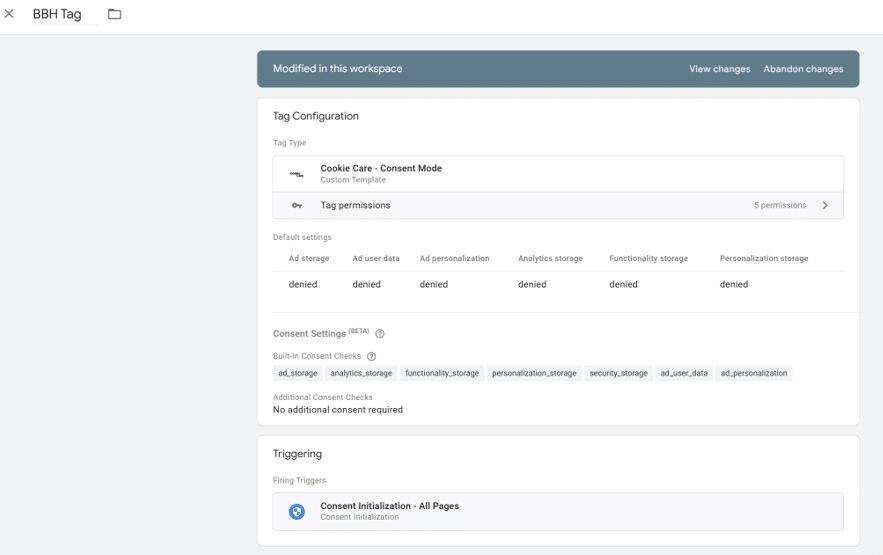
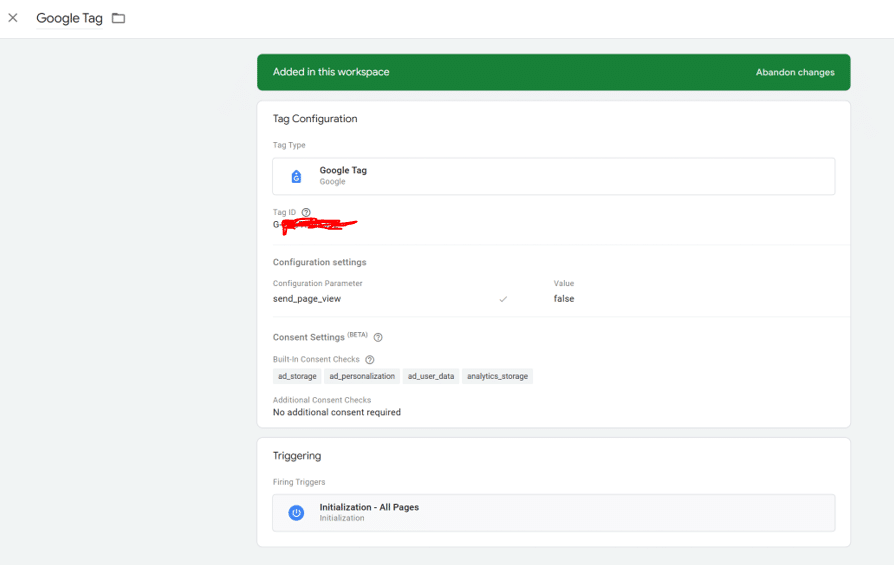
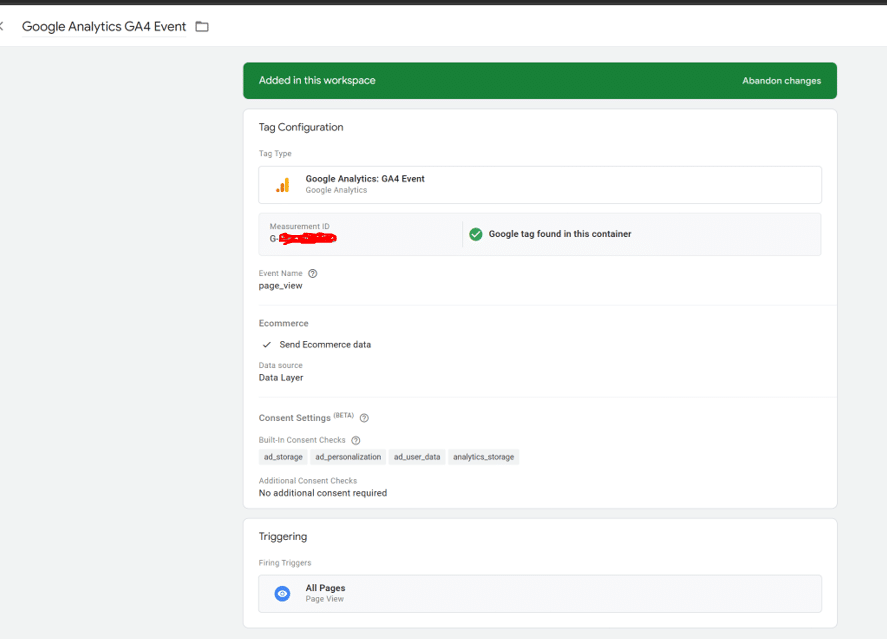
Step 5: Integrate with Cookie Care
- Log in to your website with Cookie Care and navigate to the Integration page in the Cookie Care menu.
- Locate the Google Tag Manager ID field and enter the ID obtained in step 1.
- Ensure there are no spaces and click “Save Changes.”
Step 6: Using the Consent Mode Template (Conditional)
The settings referenced in this step is the ones from inside the Integration page, in the Cookie Care plugin.
- If using the template: Check the box just below the Google Tag Manager ID field.
- Proceed to step 8.
- If NOT using the template: Refer to step 4 of the “Google Analytics Setup” section.
Step 7: Testing
- To verify the setup, use Google Tag Assistant. If you’re unfamiliar with Tag Assistant, it’s recommended to learn its functionality before proceeding.
- Open your website with Tag Assistant.
- Look for the first five events displayed as in the provided image (initial indication).
- If it says that your “GTM-XXXXX has not been published, click the button Debug “live” version. You may not see all the events, but you should at least see the ones below, and the rest of the events should work properly.
- If it says that your “GTM-XXXXX has not been published, click the button Debug “live” version. You may not see all the events, but you should at least see the ones below, and the rest of the events should work properly.
- Interact with the cookie banner in the Tag Assistant debug window and update your consent.
- You should observe several additional events, depending on your updated consent settings.
- Below the displayed events, a new “Consent” event should appear, reflecting the updated consent level. The API call for this event should be “gtag(‘consent’, ‘update’, {…})”.
Step 8: Submit
After testing, make sure to press the Submit button, that is found beside the Preview button. By submitting you make sure that changes you made to Google Tag Manager is reflected on your site.
- If you used the Debug “live” version when testing, make sure to test again, and make sure the first events are equal to the ones below.
